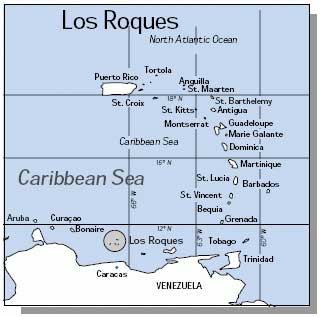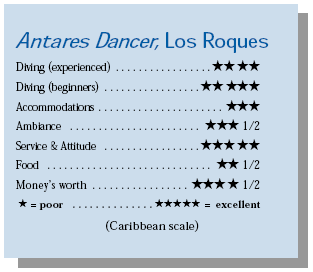Adding It Up in Venezuela’s CaribbeanContents of this Issue: Adding It Up in Venezuela’s Caribbean No More Sea Lice; No More Jellyfish Stings The Survivor Whose Torch Still Flickers New Destinations on Land and at Sea Dramamine, Sudafed, and Ginger If They're Going to Feed the Fish, At Least Teach Them to Dive Two More Reasons Not to Feed the Fish Can You Control Your DCS Risk? Perfect Prints From Slides Every Time? Editorial Office: Ben Davison Publisher and Editor Undercurrent 3020 Bridgeway, Suite 102 Sausalito, CA 94965 Aboard the Antares Dancer from the October, 2000 issue of Undercurrent
Dear Fellow Diver: For several thousand years philosophers and mathematicians -- including Aristotle, practitioners of Gestalt, ancient Indian Sammatiya priests, and modern holistic advocates -- have discussed the notion of “the whole being greater than the sum of its parts.” My recent trip on Peter Hughes’ Antares Dancer proved, at least to me, that such a seemingly impossible equation can be true. The week’s experience, like my wife’s Brunswick stew, was much better than a simple summation of the various ingredients would suggest. Diving in Venezuela’s starkly beautiful Caribbean archipelago of Los Roques did not produce any adrenalinecharged moments with whale sharks, manta rays, or reef sharks. The Dancer, much like an aging hooker covered with cosmetic paint, proved serviceable. Chef Rafael’s meals rated not much higher than “pretty good.” Nevertheless, by adding a cheerful and enthusiastic crew, diving on pristine reefs overflowing with reef fish and corals, beautiful weather, and a compatible group of fellow divers, I logged a memorable and high quality trip -- a whole greater than the sum of its parts.
Near week’s end we had an interesting dive led by the normally reclusive Captain Raoul. As dusk neared, he led us through a labyrinth of coral heads searching for, and finding, several nurse sharks resting peacefully (at least until we arrived) in mini-caverns under the reef. Night dives were fun, though usually held to the requested thirty minutes. Lobster and crab were evident, and sleeping parrotfish, some of them dressed in magnificent self-spun cocoons, added color. As I swept my light across the reef, red-eyed shrimp blazed tiny lights, then disappeared when I approached. An encounter with a resting turtle bigger than the old-fashioned Saturday night wash tub was a thrill. In these waters an observant diver would see most of the Caribbean underwater life featured in Paul Humann’s excellent series of books. Los Roques was designated a marine park in 1972, and I understand that only line fishing is allowed. The reefs' richness and life shows the effects of conservation efforts. True, there were no big creatures like those that draw divers to Cocos, but for beautiful, unspoiled reefs with prolific fish and corals, this is one great location. As in most marine parks, the forces of good and evil compete. Before my trip, the Venezuelan Coast Guard rolled up a large sea cucumber harvesting operation allegedly bankrolled by Japanese yakuza. They had expected an enormous profit from selling thousands of dried trepang in Asia. Appearance-wise the Antares Dancer is not the queen of the Hughes’ fleet. Built in 1972, she shows her origins as a steel-hull fishing trawler. After extensive refurbishing in 1999, she is surprisingly spacious for her 85-foot length and 22-foot beam. The secret to the roominess is keeping the guests to twelve and using a new 35-foot dive tender. Since dive gear is kept in the tenders for the week, the tiny size of the aft deck is not a problem. Photographers have a threelevel table for storage as well as a large rinse tank, although it’s still not as spacious as most serious shooters would like. But with the two tables in the salon and additional tables on the top deck, there is room aplenty. The top deck, aft of the wheelhouse, has a large shaded area with tables and chairs for reading, conversation, and relaxing. For those who ignore warnings about sun and skin cancer, the deck has open space with lounge chairs. An ice maker and a cooler loaded with soft drinks and beer is behind the large bar. The salon/dining room is roomy enough as well, though it’s not air-conditioned. Still, although temperatures on my August trip hovered in the 80s, cross breezes from the louvered windows kept it comfortable. Two tables seat twelve guests comfortably, though two at each table have to play musical chairs if they want to leave early. To the rear is an entertainment center with television, VCR (VHS and 8mm), and CD/tape player as well as a banquette for six people. Forward is a sidebar with ever-present cookies and peanuts, filled ice bucket, tea, coffee, and soft drinks. While there is a good supply of booze, this boat, like all Hughes’ vessels, rigorously enforces the “your first drink ends your diving for the day” rule. The cabins are more spacious than I usually find on live-aboards, especially
considering the relatively small size of the Dancer. Two forward on the main
deck rate as “master staterooms” and sport a television and VCR. Except for his cheerful and happy nature, Chef Rafael could be a shorter, more rotund version of the Seinfeld Soup Nazi character. He is indeed a master of soup, from pumpkin to broccoli to cheese to yucca, which he served at every meal except breakfast (that included fresh fruit like pineapple or mango, eggs to order, and occasionally French toast or pancakes). After the first morning dive, he offered a tasty cake or quasi-brownie and provided afternoon hors d'oeuvres. Varied and filling lunches (beginning with soup) included a Cheeseburger in Paradise Day, a staple of the Hughes menu. A special Venezuelan shredded beef with a thick version of a tortilla was quite good, as was a Tex- Mex spread of chicken and beef with tacos, frijoles, salsa, and guacamole. The four-course dinner started with the soup du jour and a fresh salad, then perhaps a fried breaded fish with mashed potatoes and carrots, baked chicken with rice and cole slaw, or grilled steak with rice and vegetables. Desserts ranged from a type of flan to Jell-O and cake. Wine was served at the evening meal, and the fancy tablecloths and napkins added Peter’s usual touch of class. Yet, despite Chef Rafael’s prowess with soups, his evening main courses rarely rated better than “pretty good,” though still better than some live-aboard food I’ve had. Venezuelan cuisine can be superb, especially the fresh seafood that’s available all over the coast -- why no fresh fish on this boat, I must ask? Señor Hughes needs to step up the quality of the evening meal. Nonetheless, the three offerings a day, plus snacks, made the whole, once again, greater than the sum of the parts. On a live-aboard trip, however, the cabins, the salon, and the meals are all secondary to the dive operation, and here the elements of the equation again yielded a whole greater than its parts. Divemaster Juan Carlos, a handsome and charming Venezuelan of Italian ancestry, ran a top-notch operation. The first evening he explained the diving and the procedures clearly and concisely. He addressed us as “my friends,” a nice touch I preferred to the “you guys” I often hear. The dive day started with a white-board briefing. He presented the dive plan, the marine life expected, and advice for photographers, then welcomed questions. For our trip a young university student named Vanessa, who was studying the Los Roques lobster population for her senior thesis in marine biology, served as assistant divemaster. Her English was excellent, as might be expected from a dual citizenship lovely who attended grade school in the states. After the briefing, we donned skins and suits and were helped into the tender. Tanks pumped to 3000 psi were already set up with BCs and placed snugly into molded holes in the built-in benches. Masks, fins, weight belts, and snorkels were stowed under the seats. During the 5-10 minute run to the sites, I geared up and prepared for the backroll over the high gunwales. Juan Carlos and Che, the tender driver, handed down cameras and otherwise helped. Divers were free to do as they wished and, as you might expect, serious shooters dived solo. When the dive was finished, usually at the requested sixty minutes, Che drove to floating divers, who handed up weight belts, fins, and tanks, and climbed a sturdy metal ladder onto the tender. If you left your tank on, a crew member would tank-walk you back to your seat -- "safety first" is not a bad way to go on a rolling boat. The bench seating can be restrictive -- shoot for the seats fourth back from the front. The sturdy overhead canvas awning was a welcome sunshield. Back at the Dancer, crew members helped with the transfer from tender to boat, took skins and suits for rinsing, and draped a warm towel over my shoulders. There is a freshwater shower, but the area is crowded. After the night dive, they offer hot chocolate with brandy at the aft deck. An aside -- because of Juan Carlos’ courteous nature and the “relaxed pace” of some divers, the dive day can slip away and the last dive can be canceled or the surface intervals shortened. I’ve seen this on other trips, and never know what to do about it. Nobody wants to be on a vacation with a boot camp drill instructor screaming about schedules, yet it’s impolite for my fellow divers to dawdle when the dive bell rings. I guess the best I can do is offer gentle hints, then grin and bear it. Another element in my semi-mathematical evaluation of a dive trip is the congeniality of fellow guests. This was a week of good fellowship, good stories, and good memories. With a French couple and an Italian duo, we were an international crowd. The Italian lady, who spoke English with an Oxford accent, translated Dutch novels into Italian. A couple from Pennsylvania seemed to have logged more dives than Jacques Cousteau, and we exchanged tales of dive scows we had known and memories of great dives around the world. An OB/GYN had fascinating tales to tell of the future world of cloning. Never missing a dive, she was a scuba fanatic as well as a virtual dive store of computers, masks, fins, still and video cameras, lenses, housings, video lights, and strobes. A duo from Northern California contributed tales of trans-Pacific sailing. A retired Naval architect spun tales of submarine construction and disaster, golfing adventures, and the intricacies of wine making -- good folk all, and good times at sea. There were other diversions. We visited a turtle farm on Dos Mosquises where turtles are studied, eggs hatched, and babies released. We had several interesting slide shows on local marine life which emphasized the REEF survey program. A video of the week’s activities (available for purchase) was shown to general laughter. Friday we had several hours to walk around the tiny and charming fishing village of Gran Roque. The pastel homes and small inns, the sand streets, the dominating peak topped by an ancient lighthouse, and the harbor with an assortment of day boats and sailing vessels all provide a very laid-back scene for hundreds of Venezuelans and Europeans to vacation. Venezuela is a friendly country with remarkable ecotourism -- consider a side trip with Lost World Adventures in Marietta, Georgia (800-999-0558). To sum, as it were: The Antares Dancer can provide an excellent week of relaxed diving among zillions of reef fish and healthy corals. Although the dives are described as drift dives, my experience was one of gentle suggestions of current, good visibility, and calm waters. Despite some visual signs of aging, the Dancer is a good boat and offers good food, an excellent crew, and comfortable cabins. Put it all together, and the total experience is somehow greater than the sum of its parts. - E.E.
|

I want to get all the stories! Tell me how I can become an Undercurrent Online Member and get online access to all the articles of Undercurrent as well as thousands of first hand reports on dive operations world-wide
| Home | Online Members Area | My Account |
Login
|
Join
|
| Travel Index |
Dive Resort & Liveaboard Reviews
|
Featured Reports
|
Recent
Issues
|
Back Issues
|
|
Dive Gear
Index
|
Health/Safety Index
|
Environment & Misc.
Index
|
Seasonal Planner
|
Blogs
|
Free Articles
|
Book Picks
|
News
|
|
Special Offers
|
RSS
|
FAQ
|
About Us
|
Contact Us
|
Links
|
3020 Bridgeway, Ste 102, Sausalito, Ca 94965
All rights reserved.

 The Dancer usually offers five dives a day, and one
dive found me at 125 feet off a Cayo Sal sloping wall,
marveling at a small squadron of eagle rays flying under
my fins. In excellent visibility the fans and whips of the
wall provided a rich backdrop for thousands of reef fish
engaging in their mating and eating rituals. Easing up the
slope, I mentally added more species to the “Reef Fish
Survey” worksheet that they had assigned me. Peter Hughes
is involved in the Reef Environmental Education Foundation
(REEF), and we added to the fund of knowledge of fish species in the southern Caribbean. Recalling it
now, the list seemed endless, but angelfish,
schooling chub, ubiquitous barracuda, lurking groupers,
patrolling jacks and mackerels, and a profusion
of parrotfish were evident. On the reef top
were scorpion fish, jawfish, and toothy lizardfish.
The green moray population was hale and healthy.
Many of us raved about the number of juvenile spotted
drums dancing under coral. The hogfish population
thrived. I saw spotted anemones on every dive,
and arrow crabs and Pederson shrimp were busy
cleaning up their world. The number of trunkfish
was notable; I was fascinated by two who engaged in
the marine equivalent of fisticuffs to win the
attention of a waiting female.
The Dancer usually offers five dives a day, and one
dive found me at 125 feet off a Cayo Sal sloping wall,
marveling at a small squadron of eagle rays flying under
my fins. In excellent visibility the fans and whips of the
wall provided a rich backdrop for thousands of reef fish
engaging in their mating and eating rituals. Easing up the
slope, I mentally added more species to the “Reef Fish
Survey” worksheet that they had assigned me. Peter Hughes
is involved in the Reef Environmental Education Foundation
(REEF), and we added to the fund of knowledge of fish species in the southern Caribbean. Recalling it
now, the list seemed endless, but angelfish,
schooling chub, ubiquitous barracuda, lurking groupers,
patrolling jacks and mackerels, and a profusion
of parrotfish were evident. On the reef top
were scorpion fish, jawfish, and toothy lizardfish.
The green moray population was hale and healthy.
Many of us raved about the number of juvenile spotted
drums dancing under coral. The hogfish population
thrived. I saw spotted anemones on every dive,
and arrow crabs and Pederson shrimp were busy
cleaning up their world. The number of trunkfish
was notable; I was fascinated by two who engaged in
the marine equivalent of fisticuffs to win the
attention of a waiting female. They’re similar
in size to the “deluxe staterooms” on the bottom deck. The air-conditioning
units, with separate controls for each
cabin, could chill a side of beef. All
cabins have separate bathrooms with
toilet and shower and warm water,
adequate for showering but not hot
enough for a good shave. Five of the
six have two beds side-by-side; cabin
six has bunk beds and is more susceptible
to noise and odors from the
bilge and engine room. Each has small
closets and under-bunk drawers. A
night stand separates the beds, which
have good reading lights. David, the
steward, kept the rooms clean and
changed towels and linens regularly.
The marine toilets worked well, probably
because we were instructed to put
used toilet paper into a nearby wastebasket,
which they removed daily.
Although the more fastidious might
wrinkle their nose at this arrangement,
the week of problem-free toilet operation made it acceptable to me.
They’re similar
in size to the “deluxe staterooms” on the bottom deck. The air-conditioning
units, with separate controls for each
cabin, could chill a side of beef. All
cabins have separate bathrooms with
toilet and shower and warm water,
adequate for showering but not hot
enough for a good shave. Five of the
six have two beds side-by-side; cabin
six has bunk beds and is more susceptible
to noise and odors from the
bilge and engine room. Each has small
closets and under-bunk drawers. A
night stand separates the beds, which
have good reading lights. David, the
steward, kept the rooms clean and
changed towels and linens regularly.
The marine toilets worked well, probably
because we were instructed to put
used toilet paper into a nearby wastebasket,
which they removed daily.
Although the more fastidious might
wrinkle their nose at this arrangement,
the week of problem-free toilet operation made it acceptable to me.  Diver’s Compass: Peter Hughes' Antares Dancer: 800-932-
6237 or 305-669-9391; website:
Diver’s Compass: Peter Hughes' Antares Dancer: 800-932-
6237 or 305-669-9391; website: 